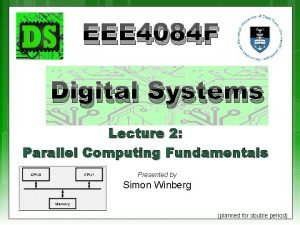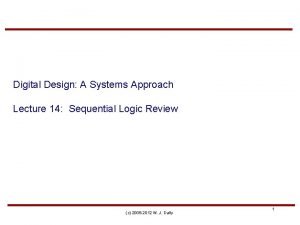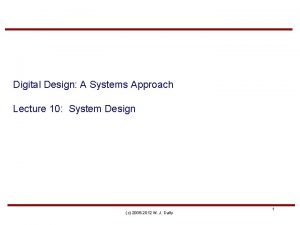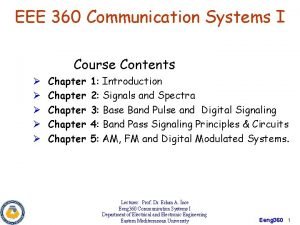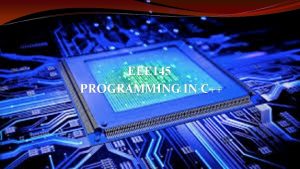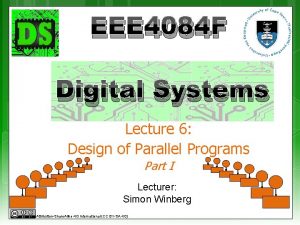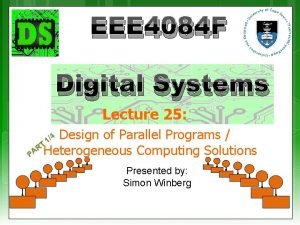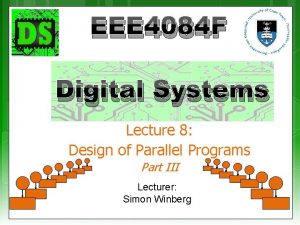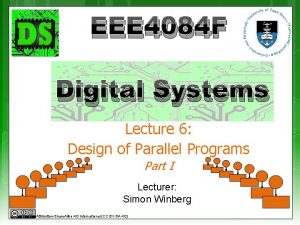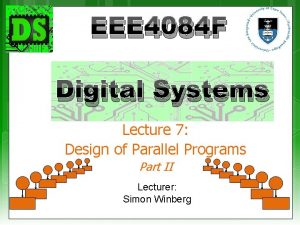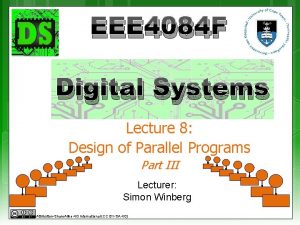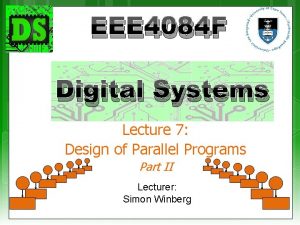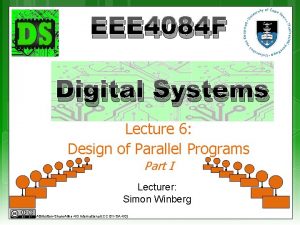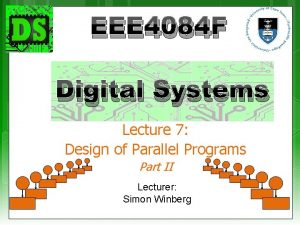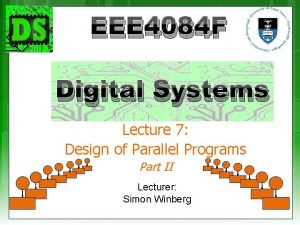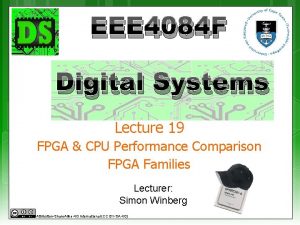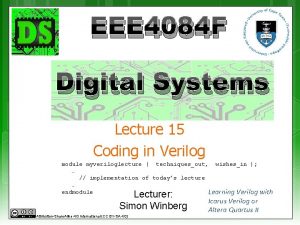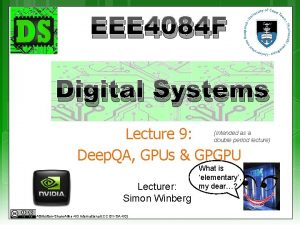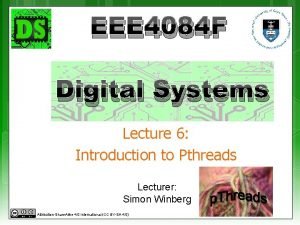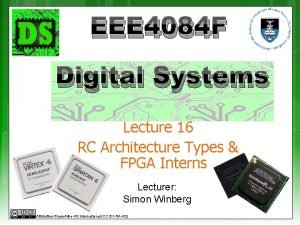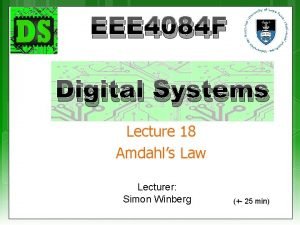EEE 4084 F Digital Systems Lecture 10 Design








![Load Balancing – simple trial prog_start technique idle logt[1]. start … typedef struct { Load Balancing – simple trial prog_start technique idle logt[1]. start … typedef struct {](https://slidetodoc.com/presentation_image_h2/bcbb19e2a3cca15ff33d3d563e13f9af/image-9.jpg)



















- Slides: 28

EEE 4084 F Digital Systems Lecture 10: Design of Parallel Programs Part IV (final part of design of parallel programs) Lecturer: Simon Winberg Attribution-Share. Alike 4. 0 International (CC BY-SA 4. 0)

Lecture Overview Planning ahead Step 7: Load balancing Step 8: Performance analysis and tuning

Planning ahead for Term 2 week 1 Delving Prac into some Verilog & FPGA issues 4 (FPGA and Xilinx ISE + Verilog) Practical Thursday 2 pm 4: RTC on FPGA (16 April) Quiz 3 (imminent announcement will indicate the syllabus concerned)

Planning re term 2 pracs + project Please look at FPGA HDL resources on the EEE 4084 F site, re Prac 4: Verilog reference http: //www. rrsg. ee. uct. ac. za/courses/EE E 4084 F/Resources/Assignments/Verilog_ Reference. pdf Verilog cheat sheet http: //www. rrsg. ee. uct. ac. za/courses/EE E 4084 F/Resources/Assignments/Cheat_S heet. pdf

Quiz 3 Syllabus Lecture 8: Lecture 9: from slide 14 (GPUs - you can skip the IBM Watson slides) but you need not know details of programming in CUDA. Slide 26 - onwards (data dependencies and synchronization) is where questions are likely to be asked. Lecture 9 B: Design of Parallel Programs Part III you should know the principles but you don't need to remember the code constructs; if you need to write any e. g. Open. CL code you'll be given a list of functions and relevant information so you don't need to remember the syntax and library details which you would regardless be able to look up where you programming at a PC. Seminar 6 (today’s seminar)

Steps in designing parallel programs The hardware may come first or later The main steps: 1. Understand the problem 2. Partitioning (separation into main tasks) 3. Decomposition & Granularity 4. Communications 5. Identify data dependencies 6. Synchronization 7. Load balancing 8. Performance analysis and tuning

Step 7: Load Balancing EEE 4084 F

Load Balancing Distributing work among tasks so that all tasks are kept busy most of the time Mainly a minimization of idle time Relevant to parallel programs for optimizing performance. e. g. , if every tasks encounters a barrier synchronization point, the slowest task will end up limiting the overall performance. Relevant to costing, e. g. deciding number of processors needed (can also be used in substantiating the need for a more, rather than less, expensive platform)
![Load Balancing simple trial progstart technique idle logt1 start typedef struct Load Balancing – simple trial prog_start technique idle logt[1]. start … typedef struct {](https://slidetodoc.com/presentation_image_h2/bcbb19e2a3cca15ff33d3d563e13f9af/image-9.jpg)
Load Balancing – simple trial prog_start technique idle logt[1]. start … typedef struct { unsigned start, end; } Log. Entry; Log. Entry logt[1024]; int logn = 0; logt[1]. end unsigned prog_start, prog_end; logt[0]. start logt[0]. end busy void* task (void* arg) { unsigned int end; unsigned int start = clock(); // do work // calculate time it took end = clock(); // update time log pthread_mutex_lock(&mutex); logt[logn]. start = start; logt[logn]. end = end; logn++; pthread_mutex_unlock(&mutex); prog_end } … in main() get prog_start time, create mutex & threads, wait join, get prog_end time.

Load Balancing – simple trial technique (cont). . . double calc_stat_stddev () { // calculate standard deviation of busy times int i; double sum = 0; for(i = 0; i < logn; i++) sum += logt[i]. end - logt[i]. start; double mean = sum / logn; double sq_diff_sum = 0; for(i = 0; i < logn; ++i) { double diff = logt[i]. end - logt[i]. start - mean; sq_diff_sum += diff * diff; } double variance = (double)sq_diff_sum / logn; return sqrt(variance); } …

Load Balancing Well balanced – low standard deviation in busy time* Task 1 time busy Task 2 Time idle time busy Time idle Task 3 time busy Time idle Task 4 time busy Time idle Overall time busy Time idle Poorly balanced – high standard deviation in busy time Task 1 Task 2 time busy Task 3 Task 4 Overall Time idle time busy Time idle * You could obviously use idle time – but that’s probably more difficult if using code in prev. slide

Achieving load balance Two 1. general techniques… Equally partition work as a preprocess 2. Workload can be determined accurately before starting the operation Dynamic work assignment For operations where the workload is unknown, or cannot be effectively calculated, before starting the operation

Achieving balance – Work assignment as pre-process Examples include Array or matrix operations for which each task performs similar work. Can evenly distribute the data set among tasks / available processors. Loop iterations where the work in each iteration is similar, and can be evenly distributed. May be less easy to do if using a heterogeneous mix of machines that have varying performance characteristics. In such cases, a comprehensive analysis tool may be needed to determine load imbalances and revise work disctribution.

Achieving balance – Work assigned dynamically Examples include Sparse arrays/matrices (i. e. , if matrix simply divided equally, some tasks may have lots to do but others little to do) N-body simulations (particles owned by some tasks may involve more work than others) Adaptive grid refinement (some tasks may need to refine their grips) General principle: tasks that are busier send a request for assistance, whereas tasks that complete quickly are available to help the busier tasks.

Vertical vs. horizontal load balancing Load Balancing with Cloud Computing. mp 4

Vertical vs. horizontal load balancing Vertically: More power, but centralized (one app. may run faster / more response / less latency for RT) Adding CPUs + memory to one system More dependent on one machine / group of closely coupled machines Horizontally: More power, but wider distribution (more apps able to run at one time) Simpler scalability More distribution / redundancy / better risk management

Step 8: Performance analysis EEE 4084 F

Performance analysis Simple approaches involve using timers (i. e. , as shown in previous code snippet) Usually quite straightforward for a serial situation or global memory Monitoring and analyzing parallel programs can get a whole lot more challenging than for the serial case May add comms overhead Needing synchronization to avoid corrupting results, … could be a nontrivial algorithm itself

MPI Timing functions MPI_Wtime the elapsed wall clock time in seconds (a double) on the calling processor Returns MPI_Wtick the timer resolution in seconds (a double) of MPI_Wtime. Returns

Std. C: gettimeofday Very portable, part of the Std. C library Should be available on any Linux system Returns time in seconds and microseconds since midnight January 1 1970 Uses struct timeval comprising tv_sec : number of seconds tv_usec : number of microseconds* Converting to microseconds will use huge numbers, rather work on differences * Word of caution: some implementations always return 0 for the usec field!! On Cygwin, the resolution is only in milliseconds, so tv_usec in multiples of 1000. Not provided in Dev. C++.

gettimeofday example See timing. c code file #include <stdio. h> #include <sys/time. h> #include <time. h> struct timeval start_time, end_time; // variables to hold start and end time int main() { int tot_usecs; int i, j, sum=0; gettimeofday(&start_time, (struct timezone*)0); // starting timestamp /* do some work */ for (i=0; i<10000; i++) for (j=0; j<i; j++) sum += i*j; gettimeofday(&end_time, (struct timezone*)0); // ending timestamp tot_usecs = (end_time. tv_sec-start_time. tv_sec) * 1000000 + (end_time. tv_usec-start_time. tv_usec); printf("Total time: %d usec. n", tot_usecs); }

Benchmarking Process of measuring performance of DS A program that Quantitatively evaluates computer Hardware and software resources Benchmark suites – sets of benchmarks defined to get better system picture Suitable benchmark for a system leads to an effective system

Benchmarking (cont…) What can be benchmarked? ( In DSP Compiler, Processor, Platform) Compiler – Converts High Level Language to Assembly language thus we benchmark compiler efficiency The Processor – code should be an Assembly (No more high level code) Platform – Written in High Level language(Processor & Compiler)

Benchmarking: what to measure In DSP/HPEC systems we benchmark Cycle count, Data and Program memory usage, Execution time and Power consumption What can we benchmark in Databases/Web servers (i. e Oracle, My. SQL, SQL Server)? SPEC defined several benchmarks in the digital world - SPECweb 99, SPECmail, etc.

Benchmark: Approaches Metrics (MIPS, MOPS, MFLOPS, etc) – not really meaningful in RISC architectures(Why? ) Complete DSP Application – consumes time and effort as well as memory because it measure the whole system DSP Algorithm Kernels – extracted from real DSP programs and consist of small loops which perform number crunching, bit processing, etc. (see pg. xx in ref)

Benchmarking: Types EEMBC (pron. embassy) – For embedded System and written in C BDTIMARK – a DSP benchmark suite Check this paper for a List of FPGA benchmarking types: Raphael Njuguna: A Survey of FPGA Benchmarks Available at: http: //www. cse. wustl. edu/~jain/cse 56708/ftp/fpga. pdf) -- might be in a quiz More Reading: Performance evaluation and Benchmarking, Lizy K. John and Lieven Eeckhout, Taylor & Francis Group

End of: Design of Parallel Programs

Disclaimers and copyright/licensing details I have tried to follow the correct practices concerning copyright and licensing of material, particularly image sources that have been used in this presentation. I have put much effort into trying to make this material open access so that it can be of benefit to others in their teaching and learning practice. Any mistakes or omissions with regards to these issues I will correct when notified. To the best of my understanding the material in these slides can be shared according to the Creative Commons “Attribution-Share. Alike 4. 0 International (CC BY-SA 4. 0)” license, and that is why I selected that license to apply to this presentation (it’s not because I particulate want my slides referenced but more to acknowledge the sources and generosity of others who have provided free material such as the images I have used). Image sources: Man running up stairs - Wikipedia (open commons) Chocolate Chip Biscuit - Wikipedia (open commons) Scales, Checked Flag - Open Clipart (http: //openclipart. org) Calendar Planning Image, Note pad – Pixabay (Public Domain CC 0) Yoga lady - adapted from Open Clipart
 Q6 4084
Q6 4084 01:640:244 lecture notes - lecture 15: plat, idah, farad
01:640:244 lecture notes - lecture 15: plat, idah, farad Digital systems testing and testable design
Digital systems testing and testable design Digital design: a systems approach
Digital design: a systems approach Digital design a system approach
Digital design a system approach Digital system design using verilog
Digital system design using verilog Eee kuet
Eee kuet Eee 360
Eee 360 Eee 322
Eee 322 Eee 121
Eee 121 Eee 431
Eee 431 Eee 302
Eee 302 Eee 302
Eee 302 Tahvel.edu.eee
Tahvel.edu.eee Eee 431
Eee 431 Eee 431
Eee 431 Eee 431
Eee 431 Eee 431
Eee 431 Eee 145
Eee 145 Lecc
Lecc Eee
Eee Eee 431
Eee 431 Eee 431
Eee 431 Eee g
Eee g Quality factor of rlc circuit
Quality factor of rlc circuit Properties of unit vector
Properties of unit vector Eee
Eee Animacionet
Animacionet Eee
Eee
